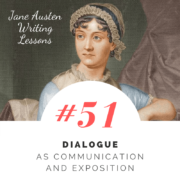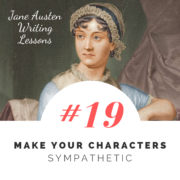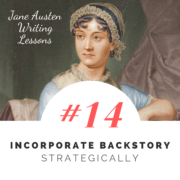Posts
#19: Make Your Characters Sympathetic
/0 Comments/in Jane Austen Writing Lessons/by Katherine Cowley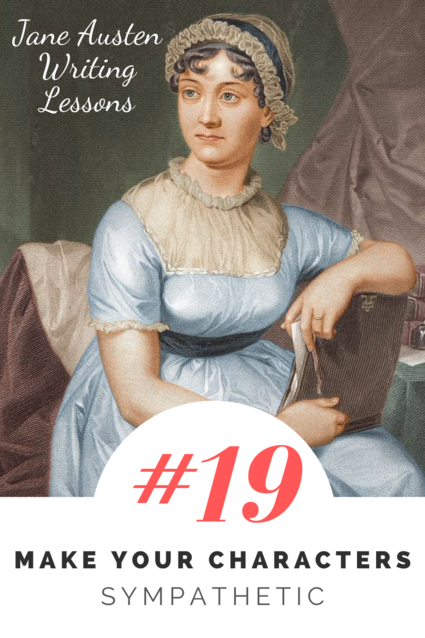
In a letter to her niece Fanny Knight in March 1817, Jane Austen mentioned that she had a new novel, nearing readiness for publication: “You will not like it, so you need not be impatient. You may perhaps like the Heroine, as she is almost too good for me.”
Jane Austen died a few months after her letter, but her family had the novel published posthumously. That novel is Persuasion, and its heroine, Anne Elliot, is—despite Austen’s self-deprecating comments—a true gift to readers.
Anne Elliot is a prime example of a sympathetic character. She broke off an engagement with Captain Wentworth ten years before the start of the novel, and now he is back in her life. She wonders—and we wonder, with just as much desperation and longing—if she will have a second chance with him.
A sympathetic character is a character who we feel compassion for and connection to. It is a character that we find likeable.
The Oxford English Dictionary (also known as the OED) is over 21,000 pages long and is probably the most massive English dictionary in the world. It is also my favorite dictionary (yes, I have a favorite dictionary). Note: I don’t own a physical copy—that would be insane, but it is online and accessible through many library subscriptions!
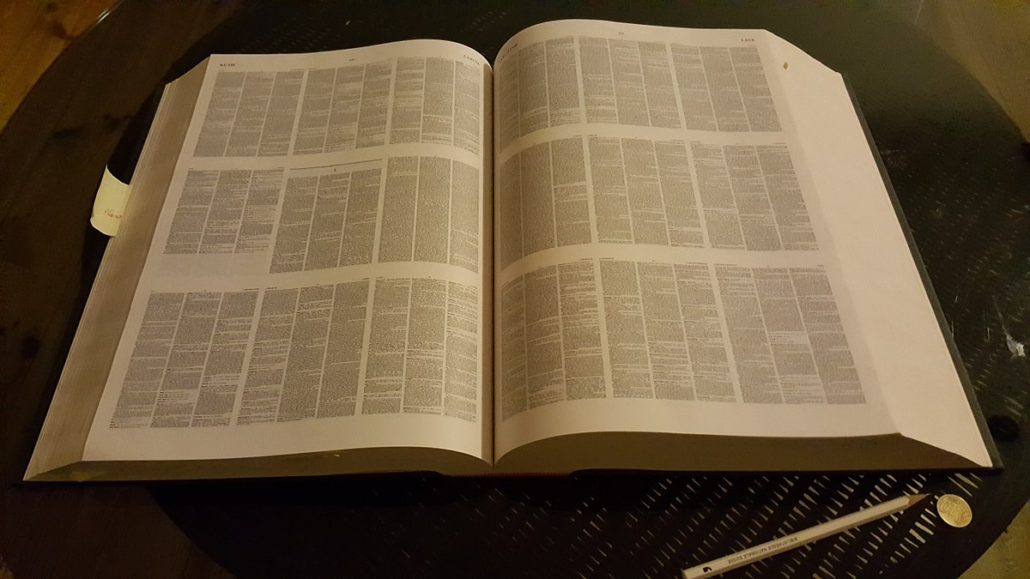
Image of the Compact OED from Aalfons. The normal version is almost two dozen huge books.
The OED goes into great depth in defining the word sympathy. We’ll look at some of the OED’s definitions of sympathy, and then use examples from Persuasion to examine how to use these definitions to create sympathetic characters.
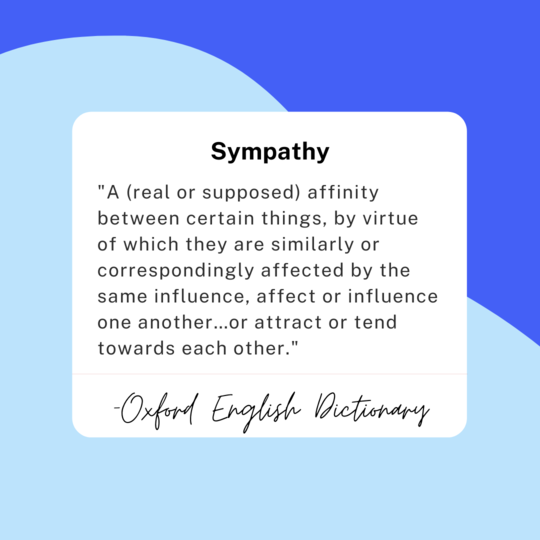
The OED cites an example from 1601 which talks about the sympathy between iron and loadstone—in other words, sympathy is like a magnet and a paperclip: there is some inherent similar quality which creates an attraction between them.
One of the main reasons we turn to literature is because stories create feelings of sympathy. We see ourselves in literature. Stories changes us. We become part of the experience in the text, and the text becomes part of our own experience.
In the latter half of Persuasion, Anne is living in Bath with her father and sister. She attends a concert with them, and Captain Wentworth is present. Anne and Wentworth have a nice conversation before the concert, but during the concert Anne is seated next to another man who is interested in her, Mr. Elliot. We see ourselves in Anne as, during the concert, she tries to catch Wentworth’s eye, but is unable to. We feel Anne’s frustrations with Mr. Elliot and his flirtation; like her, we cannot truly be interested in him. We are one with Anne and agree with her motives and her actions when she manages to change seats partway through the concert so she is at the edge of a row and has the hope of talking to Wentworth.
Captain Wentworth leaves before the concert is over:
He must wish her good night. He was going—he should get home as fast as he could.
“Is not this song worth staying for?” said Anne, suddenly struck by an idea which made her yet more anxious to be encouraging.
“No!” he replied impressively, “there is nothing worth my staying for;” and he was gone directly.
Jealousy of Mr. Elliot! It was the only intelligible motive. Captain Wentworth jealous of her affection! Could she have believed it a week ago—three hours ago! For a moment the gratification was exquisite. But alas! There were very different thoughts to succeed. How was such jealousy to be quieted? How was the truth to reach him? How, in all the peculiar disadvantages of their respective situations, would he ever learn her real sentiments? It was misery to think of Mr. Elliot’s attentions. – Their evil was incalculable.
Anne is an especially sympathetic character in this scene.
A character is sympathetic when we as readers can:
- Understand the character’s perspective
- This scene is in Anne’s point of view, and with Austen’s presentation, it is easy to understand Anne’s perspective on the situation, her history with Wentworth, and her desires. We are aided by internal thought as the narration slips into Anne’s mind and thoughts.
- This scene also helps us understand Wentworth’s perspective. He is not the point of view character, but his perspective is revealed through his dialogue and behavior, and we can understand him as a person and feel a shared humanity with him.
AND/OR
- Relate to the character’s motives and actions
- In this scene, we can relate to Anne’s motives, particularly her desire to fix things between her and Wentworth.
- Her actions are also actions that we feel like we would take if we were in the same situation.
Note that there are plenty of times when we might not relate to the character’s motives and actions—personally, I do not relate to Anne’s actions as much during the first half of the novel, when Anne avoids attempting to have an in-depth conversation with Captain Wentworth. But even if I don’t agree with her actions (or in other cases, her motives) I can understand why she’s making her choices, so I can still maintain a level of sympathy for her.
Additional techniques for creating sympathetic characters
Now we’re going to look at three more definitions of sympathy from the OED, which will help us understand additional techniques and approaches which can be used to create sympathetic characters.
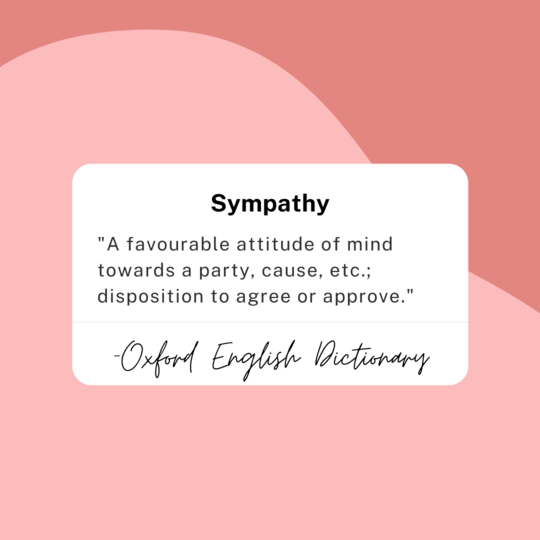
In the screenwriting book Save the Cat, Blake Snyder talks about the need for the audience to feel sympathy for the main character early on. He calls this the “save the cat” moment; in some films, the main character will literally save a cat, and this will instantly endear them to us. Basically, we feel favorably when people take actions that we can agree or approve of, and in general, as people, we approve of acts of kindness, we approve of someone doing something good or self-sacrificing. We like kind people.
Near the beginning of Persuasion, Anne has a strong “save the cat” moment. Anne’s nephew is ill, and this will prevent her sister from going to eat dinner at another family’s house. Anne’s sister very vocally and desperately expresses her desire to attend the dinner—she suffers from what today we like to call FOMO, fear of missing out. Anne has even better desires than her sister for attending the dinner—Captain Wentworth will be there, and Anne has not seen him in the ten years since she broke off their engagement.
Anne makes the decision to take care of her nephew so that her sister and brother-in-law can go to the dinner:
She knew herself to be of the first utility to the child; and what was it to her, if Frederick Wentworth were only half a mile distant, making himself agreeable to others!
Having a save the cat moment can help us sympathize with not just with a main character, but with any character. If, for example, you want us to have sympathy and understanding for an antagonist’s motives (which can be a powerful tool to make them a rounded, full character), have them do something good or kind for another character.
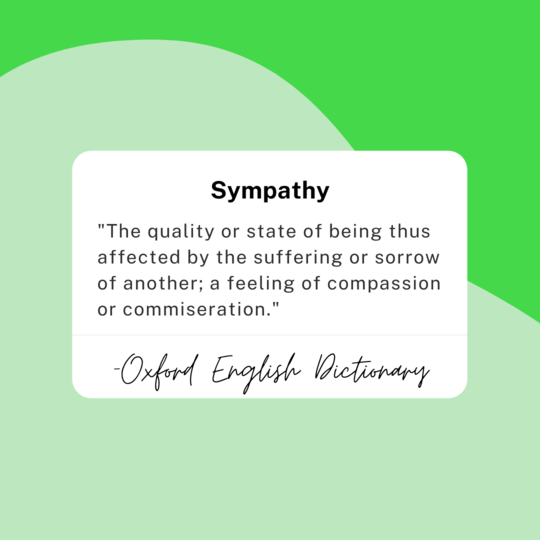
I talked about this in the post on passive characters—we sympathize with Fanny Price in Mansfield Park because of the poor way others treat her. We sympathize with suffering (though if there is too much suffering or a character feels pitiable, sometimes we find it too hard or uncomfortable to sympathize).
We also like to root for underdogs, for people who have to prove themselves. Anne Elliot is undervalued by her father and sisters; in the opening scenes of the novel, they dismiss her ideas and advice. We also see Anne suffering when Wentworth pursues another woman, and we feel for Anne in these moments.
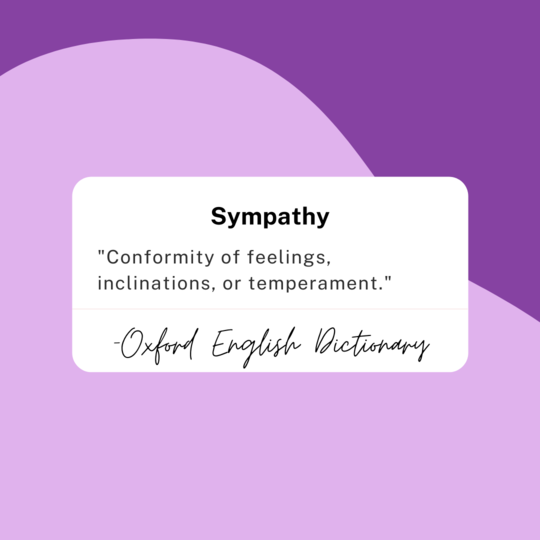
Conformity is about norms, and we sympathize with characters within certain norms. We sympathize with characters that meet our expectations of behavior and temperament. In literature, characters are often better than ourselves: they are a little more consistent, a little more understandable. They can be better examples of certain virtues or ideologies.
Yet if characters are too good or too perfect or too smart or too capable, we stop sympathizing with them. Just as in real life, we often don’t like people who seem too perfect; we feel more distance between us and characters that seem so much greater or better than us, because they are not like us.
Sympathetic characters must be like us: they must have weaknesses. They must try and they must fail, repeatedly, because it is trying and failing and trying again that makes us human.
Anne’s weaknesses are plenty: she is at times too easily persuadable. She veils her emotions. She does not stand up for herself. And because of this, she feels real and we sympathize with her struggles and failures and attempts to achieve her goals.
The Spectrum Between Sympathetic and Unsympathetic Characters
Like with active and passive characters, there is a spectrum between sympathetic and unsympathetic characters, and characters typically move up and down this spectrum over the course of a story. At times characters—even make characters—are predominantly unsympathetic. Next week I’ll focus on effectively using unsympathetic characters.
Whether your character is mostly sympathetic or only occasionally sympathetic, it helps the reader connect to the story. We like spending time with people we like, with people we have sympathy for. We root for them. And we are excited to travel with them on their journeys.

Exercise 1: There is a great Writing Excuses podcast episode on sympathetic characters (which I encourage you to listen to!). In addition to some of the points covered in this writing lesson, they address several other techniques that can help create sympathy for characters:
- Character self-awareness
- Humor
- Vulnerability and openness
Take a character from a book or film that you find sympathetic, and examine what specifically makes them sympathetic, whether it’s the point of view, suffering, backstory, imperfections, relatable motives, humor, or other principles entirely.
Exercise 2: Write a brief scene of a character doing something that we generally find unsympathetic (i.e. taking a toy from a young child, ripping up a student’s paper, etc.). Write this scene in a way that will make a reader feel sympathy for this character.
Exercise 3: Take one of your characters that is generally sympathetic and write a brief scene that makes them less sympathetic. Then, take one of your characters that is generally unsympathetic and write a brief scene that makes the more sympathetic. What did this achieve? What would the impact of this scene be on an audience? Does this scene teach you anything about your own characters?
#14: Incorporate Backstory Strategically
/0 Comments/in Jane Austen Writing Lessons/by Katherine Cowley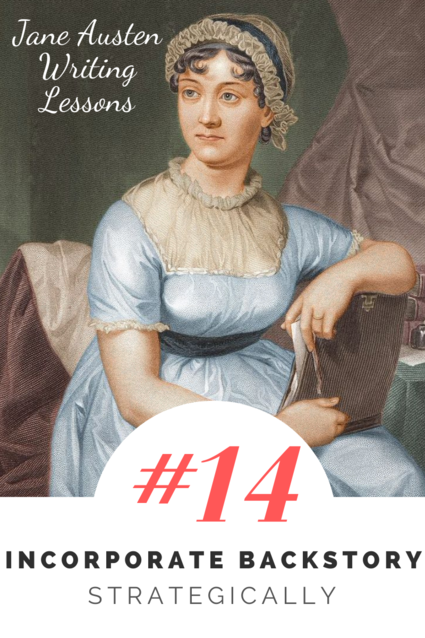
What is backstory?
Backstory is history and information about what happens before the story. Backstory is typically related to the characters, the situation, and the world in which they live.
Most backstory is never mentioned in a story—there are thousands of details and past events that inform the character and their community, thousands of excess details that your readers don’t want or need to know.
Yet there are plenty of details which the reader does need. The key is deciding how to share them.
One of the primary purposes of exposition is to provide backstory, yet too much backstory weighs down the exposition. Anytime you dive into past events, situations, details, and information, there’s a risk of creating an infodump.

An infodump is an excess of information that pulls us out of the narrative. Information is piled on the reader, who does not have direction, and who doesn’t feel any sense of connection to the information. When too much of this sort of information is given to the reader at once, none of the information has purpose or weight, and the reader often loses interest in the story.
Instead of creating a pile of information, consider the individual pieces, and how they could be incorporated. The soda can in this beach pile might not feel like garbage if we encounter it by itself, as we’re walking along the beach. We might see someone drinking it—it might bring up an interesting recollection of a past event or situation.
The author Jo Walton talks about the benefits of what she calls incluing, or “the process of scattering information seamlessly through the text, as opposed to stopping the story to impart the information.”
Backstory should be woven not just through the exposition of a story, but throughout the entire story.
Weaving in Backstory in Persuasion
In the exposition of Persuasion, Jane Austen establishes the Elliot family, the death of Lady Elliot, and the characters of the three daughters, including the oft overlooked Anne Elliot.
The heart of Persuasion is about Anne Elliot and her relationships, in particular her relationship with Captain Wentworth. Yet the crucial backstory about the relationship between them is not provided in the exposition of the novel, but is carefully woven throughout.
The Elliots have decided that in order to remain financially solvent, they must rent out their home, Kellynch Hall. In chapter 3, they discuss a possible tenant: Admiral Croft.
One line of dialogue gives us Anne’s viewpoint on the Navy:
“The navy, I think, who have done so much for us, have at least an equal claim with any other set of men, for all the comforts and all the privileges which any home can give.”
This is subtle backstory—it’s something she is saying in the moment, in response to her father’s prejudice. Yet it reveals her attitude towards those who serve in the Navy.
A few pages later, Anne is able to give specific details on what Admiral Croft is known for—that he fought in Trafalgar and has been stationed in the East Indies. Once again, this provides key backstory. As readers, we’ve learned that Anne knows much more about the Crofts than anyone in her family, yet we don’t yet know how she learned this information.
A few pages later, someone mentions that years back, someone had visited that had some connection to Admiral Croft, and after a pause, Anne volunteers a single detail.
“You mean Mr. Wentworth, I suppose,” said Anne.
Her hesitation, the lack of detail that she gives, all reveal things about Anne and her relationship with this family.
By the end of chapter 3 , Sir Walter Elliot decides that he will allow Admiral Croft to rent the estate. The chapter ends with this sentence.
No sooner had such an end been reached, than Anne, who had been a most attentive listener to the whole, left the room, to seek the comfort of cool air for her flushed cheeks; and as she walked along a favourite grove, said, with a gentle sigh, “a few months more, and he, perhaps, may be walking here.”
In this moment, we see Anne’s current emotions and thoughts, but backstory is also revealed: we are given a sense of love lost, and we see the agitation this creates for Anne.
Throughout this chapter, there have been plenty of opportunities where Jane Austen could have provided an infodump, even spots where it might be natural and not feel like an infodump. Yet by spreading the information, piece by piece, it allows the scene to build, it provokes our curiosity, it gives crucial insight into Anne’s character, and it prepares us for chapter four, when we are given a larger amount of backstory.
The first line of Chapter 4:
He was not Mr. Wentworth, the former curate of Monkford, however suspicious appearances may be, but a captain Frederick Wentworth, his brother.
The narrator then describes Captain Wentworth’s situation years before, and how he and Anne met and fell in love. It tells us of their short engagement, and how Sir Walter and Lady Russell had convinced Anne to break it off.
This is a lot of backstory, but by this point, we care about Anne and this backstory has meaning for us as readers.

A gif from the 2007 film version of Persuasion: Anne and Captain Wentworth
Incorporating Information on a Need to Know Basis
Backstory is something that I often don’t get quite right in a first draft—it’s something I finesse during revision. But how do you do it? How do you weave it?
What Jane Austen often does is provide enough context ahead of time so the reader is oriented, and then adds information and backstory as the character interacts with present, current things.
For example, Uppercross is mentioned as the residence of Anne’s older sister, Mary. Mary invites Anne to go to Uppercross and she agrees. That’s our context. That’s what’s going to keep us oriented.
A few pages later, Anne goes to stay at Uppercross. Now, as she’s arriving at Uppercross, we receive a brief description of the village.
More details are given on a need-to-know basis, as they provide context, unravel character, forward the plot, and provide insights into the emotions of the characters:
Here Anne had often been staying. She knew the ways of Uppercross as well as those of Kellynch. The two families were so continually meetings, so much in the habit of running in and out of each other’s house at all hours, that it was rather a surprise to her to find Mary alone…
Here, we receive backstory on Mary’s strong connection to Uppercross. We see how familiar she is with it. And we experience this as she enters the cottage and finds her sister (surprisingly) alone.
Using Backstory to Build Moments of Emotional Impact
Backstory can also build to moments of emotional impact.
Captain Wentworth comes to Uppercross, and soon becomes friends with Anne’s host, which means that Wentworth and Anne must interact frequently.
They had no conversation together, no intercourse but what the commonest civility required. Once so much to each other! Now nothing! There had been a time, when of all the large party now filling the drawing-room at Uppercross, they would have found it most difficult to cease to speak to one another. With the exception, perhaps, of Admiral and Mrs. Croft, who seemed particularly attached and happy, (Anne could allow no other exception even among the married couples) there could have been no two hearts so open, no tastes so similar, no feelings so in unison, no countenances so beloved. Now they were as strangers; nay, worse than strangers, for the could never become acquainted. It was a perpetual estrangement.
This is a powerful, emotional moment of backstory, in which it is revealed how similar Anne and Wentworth were to each other, and how perfectly suited they had been for each other: “there could have been no two hearts so open.” Their similarity and how well suited they are for each other could have been revealed at many points of backstory prior to this, but instead, this bit of backstory is foreshadowed and saved for this moment, when it can have the greatest emotional impact because it is placed in contrast with Anne and Wentworth’s current relationship.
When you are using backstory for large emotional impact, limit the amount of backstory used. If we didn’t find out until now that Anne and Wentworth had been engaged, and then, at this moment, we found out they had been engaged and that they had been perfectly suited, this scene would be bogged down in the amount of impact, readers would be focusing on the new knowledge that they had a broken engagement, and their similarity would no longer have the space to have the same emotional impact.
When I’m editing and I see a scene where backstory is supposed to create emotional impact, I often realize that I’ve saved too much backstory for these scene, and I have to find pieces of backstory that I can weave in earlier so they aren’t distracting the reader from the true purpose and weight of the scene.
In Conclusion
Backstory should be included not only in the exposition, but throughout the entire novel. The incorporation of backstory is particularly suited to written fiction—it is much more difficult to include in film or theatre—and it provides insight into the character’s mind, perspective, experience, and emotions.

Exercise 1: Read the following paragraph.
Sandra stood at the edge of the dock, staring into the water. She could hear the other teenagers behind her, their laughter, their utter unconcern, as if this meant nothing. This meant nothing to them. They didn’t fear the water. She dipped her toe into the lake. She would be fine. She could do this. She closed her eyes, sucked in a breath of air and courage, and jumped.
Rewrite the paragraph, and as you do so, include 1 or 2 pieces of backstory.
This backstory could be about why Sandra fears water, what happened the last time she was in the water, or what happened to someone she knows, or it could be about the troubled history of this lake, a memory from this particular spot, etc. The type of information you choose to include will impact the emotion and direction of the paragraph.
Exercise 2: Take a novel that you have read at least once before. Skip the exposition, and now skim at least two or three chapters, looking for moments of backstory. Use post-it notes to mark these moments of backstory. Now analyze the author’s use of backstory:
- When is backstory incorporated?
- How is backstory incorporated?
- Are there moments where backstory is used to create emotional impact?
Exercise 3:
Take a story you have written and choose a key emotional moment that doesn’t include any backstory. Revise the scene to incorporate an element of backstory—small or large—in a way that increases the emotional impact of the moment.

